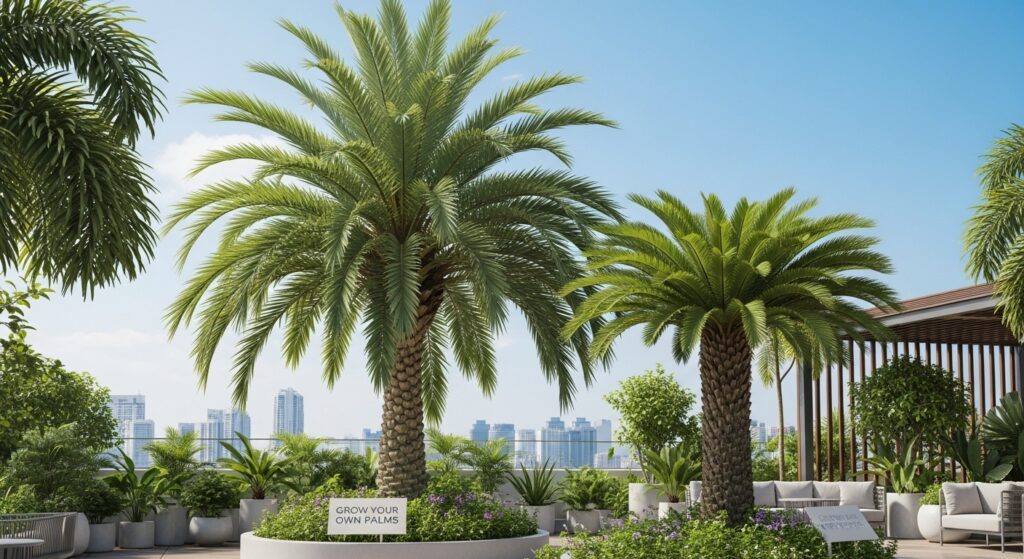Introduction
King Palm Trees bring a tropical touch to gardens, making outdoor areas look elegant and full of life. Their smooth, tall trunks and soft, feather-like leaves make them a favorite choice for landscaping enthusiasts in regions like the US, UK, and Australia. This guide covers all you need to know about growing and looking after King Palm Trees and their well-known cousin, the King Sago Palm Tree. It also explains how to grow them in tight spaces like rooftops or balconies and where to find reliable sellers for purchasing King Palm Trees.
What Are King Palm Trees?
Known scientifically as Archontophoenix cunninghamiana, the King Palm Tree comes from Australia. It grows well in warm temperate and subtropical regions. This tree can grow 40–60 feet tall when planted in the ground, while in pots it stays smaller, around 10–15 feet. Its shiny green fronds with arching leaves make it a favorite for people wanting a tropical feel in their homes.
King Palms grow best under full or partial sunlight and need soil that drains. These trees grow and require little effort to care for, so both new and experienced gardeners like them. People often plant them in groups or rows to create a striking look. They also provide shade, which makes them both useful and nice to look at.

King Palm Tree vs. King Sago Palm Tree
Gardeners often mix up King Palm Trees with King Sago Palm Trees because their names sound similar, though the plants themselves are very different.
King Palm Tree:
- The botanical name is Archontophoenix cunninghamiana.
- It belongs to the Arecaceae family, making it a real palm.
- This tree grows.
- It needs plenty of water and bright sunlight to thrive.
- It is tall and has long, feather-like leaves.
King Sago Palm Tree:
- The botanical name is Cycas revoluta, and it is not a real palm.
- This plant grows more over time.
- It survives better with less water.
- It is short, more compact, and has stiff, spiky leaves.
- People like using it for bonsai or placing it indoors.
King Palm Trees work great to add height to spacious gardens or rooftop spaces, while King Sago Palms fit better in pots for decoration. Both types suit tropical or Mediterranean-themed landscapes.
Growing King Palm Trees
Best Climate and Location
USDA zones 9 to 11 provide the right environment for King Palm Trees. These trees are well-suited to areas like California, Florida, and Texas in the USA, as well as coastal regions of the UK and various Australian locations. To grow them in colder areas, try planting them in containers so they can be moved indoors when frost shows up.
Light and Soil Conditions
These trees thrive in full sun but manage fine with some shade, too. The ground needs to drain well, be a bit acidic, and be packed with organic material. Sandy loam works best.
Planting Advice
- Pick a spot to get at least 6 hours of daily sunlight.
- Make a hole big enough to fit twice the size of the root ball.
- Blend in compost or manure that has aged well.
- Soak the plant with water after it’s in the ground.
- Spread mulch around to help lock in moisture and keep weeds away.
Growing Them in Containers on Rooftops
Use large pots or containers to plant King Palms. Choose soil that includes a mix of sand to allow water to drain well. Ensure the pot has holes at the bottom so excess water can flow out. Water more in the summer, and use fertilizer when the tree is growing.
Watering and Feeding
Water your King Palm often during its first year so the soil stays moist but not soaked. Use a slow-release fertilizer made for palms every 6 to 8 weeks in both spring and summer.
Pruning and Care
Cut off dead or yellow fronds to keep the plant looking nice. Avoid over-pruning since that might hurt the plant. Watch out for bugs like spider mites or scale insects on potted plants.
Common Problems and Fixes
- Yellow Leaves: Leaves can turn yellow if the plant gets too much water or lacks nutrients. Check how well the soil drains and add palm fertilizer to fix the issue.
- Brown Tips on Leaves: Brown tips mean the air is too dry or the soil has too much salt. Flush out the salt sometimes and spray water mist around the plant to add some moisture.
- Rotting Roots: Roots start to decay when water sits without draining. Use fresh soil during repotting and reduce how much of water the plant gets.
- Pest Problems: Pests like mealybugs or scale can be handled using insect-killing soap or neem oil.
- Frost Damage: Protect palms from frost by wrapping them in burlap or moving potted ones inside where it’s warmer.
Why Palm Trees Suit Rooftop Gardens
In cities where space is tight, King Palm Trees offer both function and charm:
- Making Good Use of Space: Palms grow tall and thin, so they fit into small rooftop gardens without crowding the space.
- Natural Shade Makers: Their leaves create a gentle dappled shade, helping cool things down on sunny days.
- Purifying Air: Palms refresh the air by soaking up pollutants and releasing oxygen, just like most green plants do.
- Noise Reduction: Their big leafy fronds can muffle noisy street sounds, adding a sense of peace to rooftops.
- Stopping Wind: Placing them can block strong winds and protect smaller plants from damage.
- Tropical Feel: Many love how palms add a vacation-like or beachy vibe to any space.
Locations to Buy King Palm Trees (US and UK)
Looking to purchase a King Palm Tree? Here are some reliable sellers to consider:
USA:
- Visit FastGrowingTrees.com
- Check The Home Depot
- Explore Palmco Nursery, based in Florida
UK:
- Try shopping at The Palm Centre
- Visit Big Plant Nursery
- Check out Paramount Plants
Always ensure the plant looks alive with green leaves and shows no damage from pests. Look into their delivery options, the sizes of the pots, and details about their growth history. Some sellers might even offer warranties for the plants they sell.
King Palm Tree FAQs
Q1: How does a King Palm Tree grow?
A: It can grow as much as 2 feet in a year when conditions are favorable.
Q2: Can it be grown inside a home?
A: Keeping it indoors for a long time isn’t ideal because it grows tall, but you can start growing it indoors.
Q3: Is the King Palm Tree safe around pets?
A: It won’t harm cats or dogs. On the other hand, the King Sago Palm is poisonous and poses a serious risk to them.
Q4: How long can a King Palm Tree live?
A: With proper care, it can live between 80 and 100 years.
Q5: Does it require a lot of space?
A: Yes, it does when you plant it in soil. But if you’re using a pot, check that the pot is large enough to hold its roots.
Conclusion
King Palm Trees add a grand and tropical vibe to gardens in warm climates or on rooftops. These trees are great if you are looking to create a tall centerpiece or a tropical atmosphere in your outdoor space. To keep them healthy, use quality soil, give them plenty of water, and make sure they get sunlight. They can remain stunning for years when cared for. If you have less room or live in a cooler area, you might want to try the King Sago Palm Tree. It looks similar, but it grows smaller and works better in a limited space.
Have you ever planted a King Palm Tree or thought about adding one to your garden? Drop your thoughts, questions, or tips on gardening in the comments!















